The presence of the iconic, blue-colored backpack sprayer in recent years in northern Lao PDR is a testament to the increasing reliance of upland farmers on phytosanitary products. Since the mid-2000s, many cultivators shifted from subsistence farming towards commercial production of a range of agricultural commodities, including banana. As the commercial cultivation of Cavendish banana variety involves large amounts of pesticide, increasing concern rose over the potential detrimental effects of commercial banana farming on the environment and human health. As a result, the Government of Laos enforced a ban on new banana plantations in January 2017. Although such policies helped bring the banana boom to a halt, they can be viewed as reflecting a lack of state capacity to regulate commercial farming expansion (Lu and Smith 2023) – and its corollary, the potential overuse of pesticides.
Currently there is a knowledge gap surrounding phytosanitary products’ usage in the context of commercial farming expansion in northern Laos (see e.g., Wentworth et al. 2021). Pesticide application rates in Laos are typically estimated by averaging the total quantity of pesticides imported (e.g., Schleiermacher’s et al. 2015). Such aggregate figures provide overall estimates, but do not offer insights into individual usage and practice, including pesticide selection and application rates. Furthermore, it is widely reported that government banned compounds, such as Paraquat dichloride, continue to be imported through unofficial channels and are used as pesticides (Vázquez 2013). Although there is a prevalent assumption that upland farmers in northern Laos are becoming more dependent on, and possibly overusing pesticides, the actual extent of this usage remains largely undocumented and unquantified.
To address such a knowledge gap, the Comité de Coopération avec le Laos (CCL) initiated in April 2023 a study assessing pesticide application rates in Oudomxay Province. The main objective of this study, conducted in the framework of the provincial task force on pesticides, is to establish objective quantitative data on phytosanitary products’ use, both inside and outside the context of contract farming. The study’s methodology is inspired by protocols aimed at calculating pesticide application intensity, particularly the Treatment Frequency Index (TFI) developed in Denmark in the mid-1980s and adapted in France in 2006. The aim of the TFI is to quantify pesticide usage based on the application rate per treatment (Brunet et al. 2008). The value for each application is given by dividing the actual doses applied per hectare on a plot by the recommended doses per hectare (see Fig. 1). The recommended rate is determined as the practical dosage at which a product can be administered to a specific crop and the intended target (e.g., pest, fungi)[1]. Standard recommended dosages are established according to the guidelines provided by the pesticide manufacturer and/or as directed on the pesticide label.
The TFI represents a potentially valuable indicator for government agencies and policymakers (Pingault et al. 2009). It offers insights into phytosanitary products’ usage and its evolution, drawing from statistical databases. By calculating TFIs, it becomes possible to shed light on the varying intensity of pesticide product usage for diverse crops. Moreover, usage values can be established for various product categories, such as herbicides, fungicides, insecticides, or others. The TFI can be computed at different levels, including the farm, regional, or national level, focusing on specific crops or groups of crops. Therefore, as indicated by Brunet et al. (2008): “The TFI provides all stakeholders, at all relevant levels of decision-making, with an objective and precise foundation to not only establish and share a common diagnosis of initial crop protection practices but also a shared vision of the goal to be achieved”.

Figure 1 – Calculating formula of TFI for a specific treatment and at plot level. By employing the same calculation methods, it becomes feasible to compute TFIs in the Laotian context at various levels, including the village, district, provincial, or national scale. Analyzing phytosanitary pressure across different levels of observation can enhance our comprehension of pesticide usage patterns as the complexity of this phenomenon stems not only from the diversity and variability of practices but also from their uneven spatial distribution.
Implementing such an index in the Laotian context poses substantial challenges. In France, TFI calculations are typically derived from farm records, where a comprehensive database contains registered doses for all commercial products used in various applications (product x crop x treatment method x target). This allows farmers to calculate their TFIs independently.
For the study implemented by CCL and its partner SAEDA, it was necessary to reconstruct both the actual doses applied by farmers and the recommended doses for each product employed. The initial phase involved identifying all pesticide products utilized, either sourced through direct commercial channels or via contract farming companies[2]. This process led to the identification of more than 190 different pesticide products. Simultaneously, an analysis of product labels was undertaken to compile a database containing registered doses for each pesticide product. The subsequent stage of the study incorporated a combination of semi-structured interviews and participant observation to document farmers’ pesticide usage (see Fig. 2 and 3). Farmers were presented with visual stimuli, including photographs of each pesticide product listed. For each selected product, various usage details were recorded, such as the quantity used, treated surface area, and dilution methods employed.

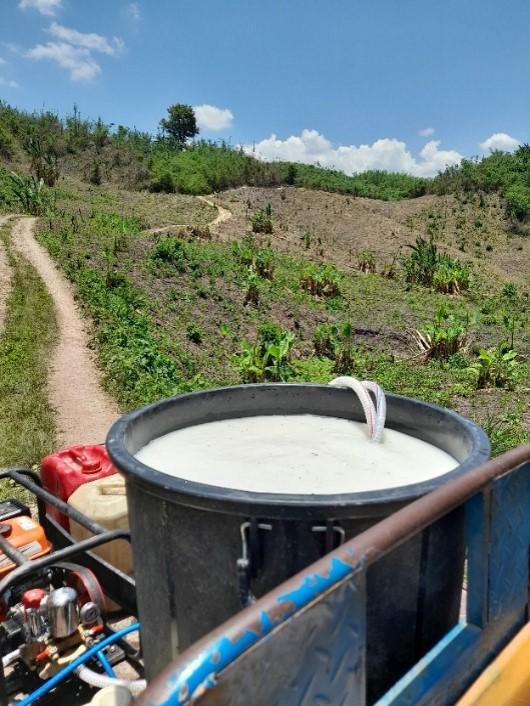
Figure 2 – Observation of herbicide application with motorised pumps. The left panel shows a labourer from a village in Namor District hired to prepare a selective herbicide mixture containing atrazine and mesotrione compounds. His remuneration was based on the number of bottles he diluted, at a rate of KIP 50,000 (approximately USD 2.50) per bottle. Working for an average of 5 to 7 farmers per season, this villager reported earning up to KIP 500,000 (around USD 25) per day, which equals 10 bottles or bags of herbicide products. The right panel shows the container typically used for herbicide spraying in maize fields, with a theoretical capacity of 200 liters. This farmer, who resides in another village within Namor District, employed a dilution ratio of 800 milliliters of herbicide to 360 liters of water. Variations in spraying practices, especially dilution ratios, may be influenced by factors such as plot accessibility and the presence of water storage points (Source: CCL; Namor District, June 2023, and May 2023).
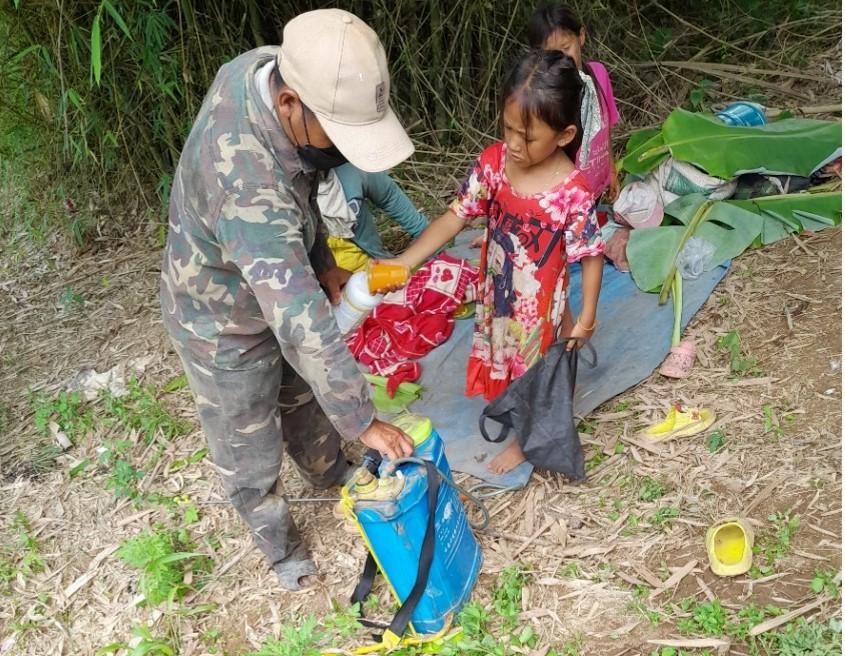
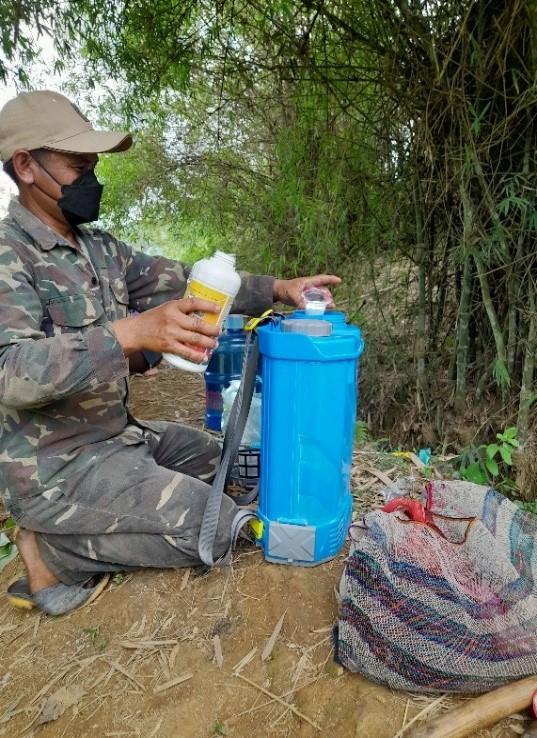
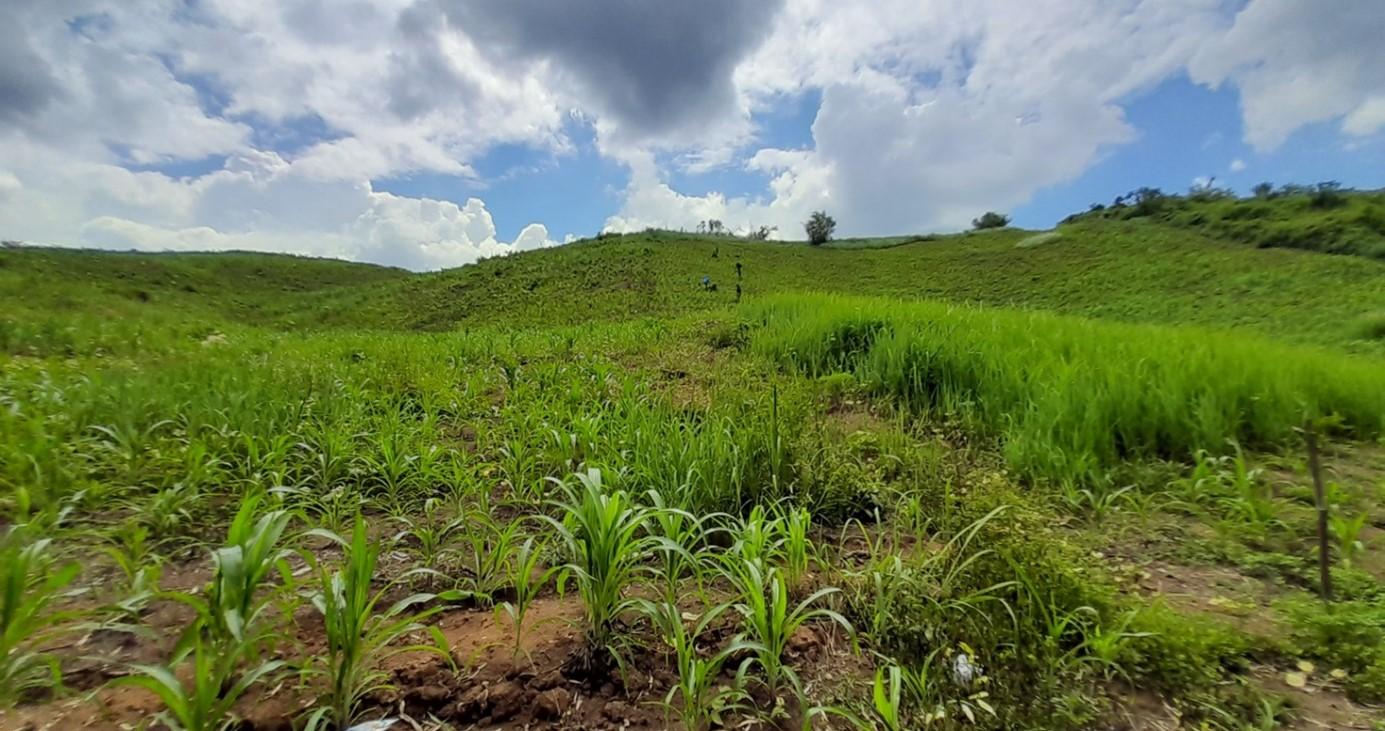
Figure 3– Observation of herbicide application with an electric backpack sprayer. The above left and right panel show a farmer from a village in Namor district preparing a selective herbicide mixture containing atrazine and mesotrione compounds. As depicted in the pictures, plastic containers of orange juice – a popular beverage among the youth in the villages of northern Laos – are often reused for the dosing of pesticide products. The observed farmer employed a dilution ratio of 160 milliliters of herbicide to 17 liters of water (i.e., one orange juice cup to one backpack sprayer). The below panel shows the outline of the farmer as he dispersed his herbicide mixture across his maize field. (Source: CCL; Namor District, June 2023).
As of January 2024, interviews have been carried out with 74 farmers who employed pesticides during the 2022-2023 growing season. The main cash crops grown in northern Laos were sampled, including maize, tobacco, pumpkins, sugarcane, long beans, and rice (both upland and lowland) [3]. A total of 356 pesticide applications were recorded, i.e. an average of 4.8 applications per farmer[4], for around 80 different pesticide products. The computation of TFIs, expected for April 2024, will provide quantitative information regarding the extent of phytosanitary product usage in northern Laos[5]. In summary, this study is expected to provide a more comprehensive understanding of pesticide usage, thus facilitating a more objective assessment of its intensity, including the potential overuse.
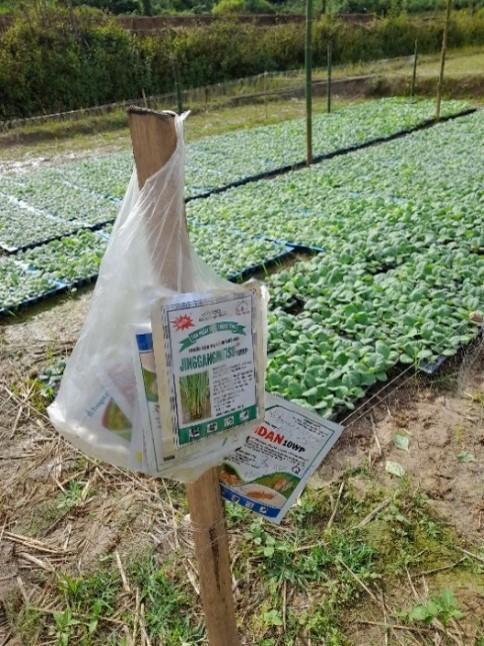
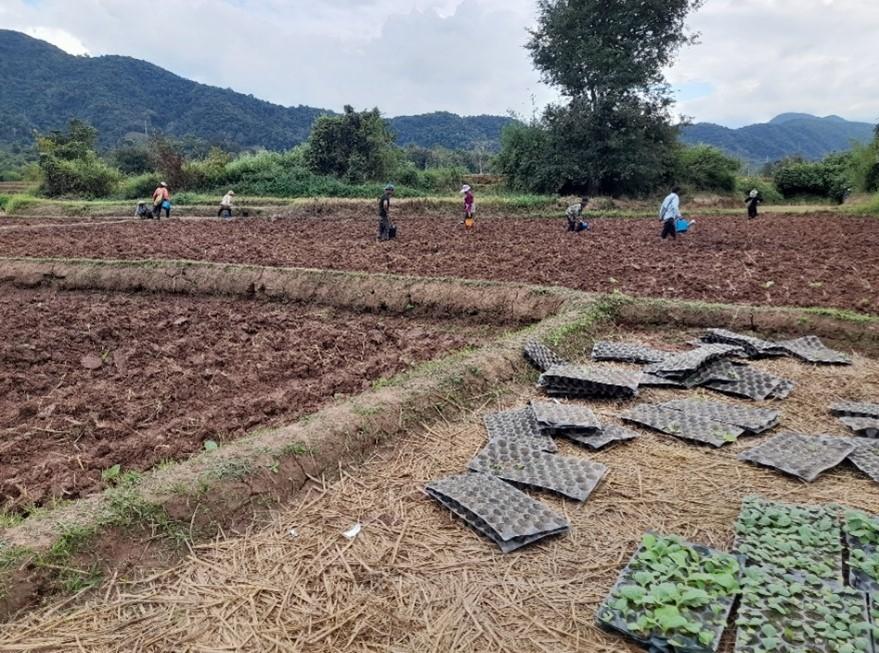


Figure 4– Pesticides and the contract farming landscape. The above right panel shows farmers from a village in La district contracted by the Lao Tobacco Company watering their tobacco plants. The above left panel show the presence of pesticide sachets distributed by the company to farmers. Each farmer receives a certain number of pesticide sachets or bottles, based on the area cultivated, and must comply with the technical recommendations defined by the company. The below left panel shows fields of long beans under contract farming arrangements with two Chinese companies. The companies carry out the dosage of pesticides themselves and distribute pre-diluted solutions to the contract farmers. The latter are generally unaware of the products used, and usually collect the pre-diluted solutions in recycled sardine tins from the companies, as shown in the below right panel. (Source: CCL; La District, December 2023).
[1] When multiple registered doses exist for the same “crop x pesticide product” combination, each addressing different pests, the minimum registered dose is used.
[2] The conduct of this study, including the inventory of pesticide products, was made possible through collaboration with the Provincial Department and District Offices of the Ministry of Agriculture and Forests, as well as the active participation of contract farming (CF) companies. Interviews conducted with seven companies led to the identification of approximately 43 pesticide products, the majority of which are not readily accessible for purchase in Oudomxay. Interestingly, the investigation revealed that at least two of these companies operated in a manner where farmers had limited awareness of the specific pesticides applied on their plots, as product selection, dosing, and pre-dilution were directly managed by CF companies (see Fig. 4).
[3] Interviews are expected to be conducted with three additional farmers growing watermelon during the 2023-2024 season.
[4] The TFI calculation only considers the application of phytosanitary products at field level, excluding seed treatments and treatments applied to harvested produce (Brunet et al. 2008: 132). Out of the 356 applications documented in the study, 77 were designated for seed treatment, with most of them being used for maize.
[5] The potential to track pesticide sales in Laos could facilitate the calculation of a “sales-based” TFI – similar to a practice adopted in Denmark (Brunet et al. 2008: 140). This “sales-driven” TFI could complement the “use-driven” TFI implemented as part of this study (Ibid.). While data on imports of phytosanitary products are available for the province of Oudomxay, it remains unclear whether pesticide sales data are available.
References
Brunet, N., Guichard, L., Omon, B., Pingault, N., Pleyber, E., and A. Seiler. 2008. L’indicateur de fréquence de traitements (IFT) : un indicateur pour une utilisation durable des pesticides. Courrier de l’environnement de l’INRA 56: 131-141.
Lu, J., and H. Smith. 2023. From booms to bans: governing land and forests in Laos. Sociology of Development 9 (2): 131-150.
Pingault, N., Pleyber, E., Champeaux, C., Guichard, L., and B. Omon. 2009. Produits phytosanitaires et protection intégrée des cultures: L’indicateur de fréquence de traitement. Notes et Études Socio-économiques 32: 61-94.
Schreinemachers, P., Afarisera, V., Heng, C.H., Dung, P.T.M., Praneetvatakul, S., and R. Srinivasan. 2015. Safe and sustainable crop protection in Southeast Asia: Status, challenges and policy options. Environmental Science & Policy 54: 357–366.
Vázquez, C. 2013. Illegal pesticide trade in Mekong countries: Case of Lao PDR. Penang, Malaysia: Pesticide Action Network Asia and the Pacific (PANAP). 24p.
Wentworth, A., Pavelic, P., Kongmany, S., Sotoukee, T., Sengphaxaiyalath, K., Phomkeona, K., Deevanhxay, P., Chounlamany, V., and V. Manivong. 2021. Environmental risks from pesticide use: the case of commercial banana farming in northern Lao PDR. Colombo, Sri Lanka: International Water Management Institute (IWMI). 66p.
